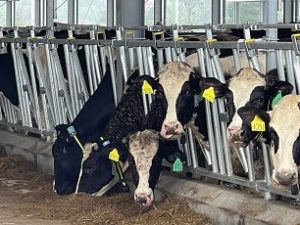Economic - Markets
Tips to Control Those Feed Costs

Professor of animal science emeritus from the University of Illinois-Champaign-Urbana, Dr. Mike Hutjens, says that feed costs are the major costs on the farm that producers can control.
“With feed representing half of total farm expenses, it’s vital to keep them under control,” he says. “The only reason to raise livestock is to increase return on crops raised on the farm.”
Independent agriculture business financial consultant, Gary Sipiorski, says knowing your costs is essential. He reports that feed costs range between 20% to 45% of the gross income, depending on how much feed you produce yourself.
“If you purchase all your feed, your feed cost will push to be around 50% of the milk check,” Sipiorski says. “Feed is the biggest cost to a dairy and each farm needs to individually evaluate depending on variables such as needs and forage quality.”
Five Tips to Control Feed Costs
Hutjens concurs with Sipiorski and offers these five tips to help producers control their feed costs.
-
Rumen fermentation is key in reducing feed costs and growing amino acids and energy sources from rumen VFA (volatile fatty acids). Consider stable rumen pH, feed bunk management, feed stability to avoid secondary fermentation and feed additives that can stabilize the rumen environment.
-
Forage quality and quantity are vital, especially for farms that grow their own forages. Having plenty of high-quality forage (defined as NDFD, RFQ, starch, uNDF, etc.) allows a higher forage to concentration ratio (perhaps 70% forage), less purchased protein supplement (rumen microbial sourced) and less corn grain (more VFA from rumen microbes).
-
Forage crop selection and hybrid varieties to get the optimal balancing for nutrients for the rumen bacteria and for dairy cows. Lower lignin forages, higher yields, and cover crops next year, are examples.
-
Processing feed ingredients to optimize nutrient availability. This includes corn silage processing, cooking corn silage for 4 to 6 months in storage, grinding corn to optimal mean particle size (400 to 600 micron), proper steam flaking density, and processing lower-quality forage shorter to minimize rumen fill factor and increase rates of passage.
-
Optimize dry matter intake as digestible organic matter. This leads to maximum microbial growth, increases marginal milk yield (last pound or liter of milk can be most profitable), and measure feed efficiency which relates 3.5 lbs. of milk per pound of dry matter consumed. Compare your herd or groups to published guidelines, such as from Ohio State University.
You cannot manage what you can’t measure certainly is true, and Hutjens says producers must value feed costs in terms of:
-
Per pound of dry matter
-
Per milk cwt (one hundred pounds)
-
Income over feed costs
-
Feed efficiency in your region
“If your feed costs in the above measurements are too high or too low, figure out why and correct it,” Hutjens says.
Matching nutrient needs to nutrient requirements is a must. Precision livestock feeding aims to match nutrient supply precisely with the nutrient requirements of individual animals, based on real-time feedback from sensors. Benefits include greater economic returns and improved efficiency of resource utilization. Hutjens suggest grouping cows by lactating cows according to fresh, early lactation, late lactation and first lactation. Also, he encourages having two dry cow programs, a fresh cow diet and six groups of heifers that are grouped by size, then age. Finally, strategically feed additives and manage overcrowding to help curb your feed costs.
Winner, Winner
When looking at what feed ingredient returns the most bang for your buck, Hutjens reports it is corn silage.
“Every analysis of feed ingredients using Sesame software from Ohio State University has the widest spread between field and break-even costs,” he says. “Corn silage brings palatability, and a wider harvest window can increase dry matter intake and plenty of starch energy to drive milk yield.”
Like it or not, high feed prices are here to stay in 2022. Work with your nutritionists or outside consultants to measure performance and optimize milk yield and components to help you gain control of your feed costs and maximize a profit for your dairy.






















